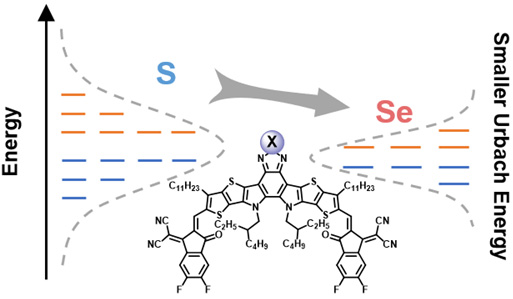Researchers Develop a Selenium Heterocyclic Electron Acceptor with Small Urbach Energy for High-Performance Organic Solar Cells
With the design concept of fused ring electron acceptors (FREAs) in 2015 (Adv. Mater., 2015, 27, 1170-1174), a series of high performance FREAs have sprung up. So far, single-junction organic solar cells (OSCs) based on an FREA with a benzothiadiazole core (Y6) have exhibited power conversion efficiencies (PCEs) of over 16% when blending several high-performance polymer donors. However, the photovoltaic performance of OSCs remains lower compared with those of inorganic solar cells. One of the main limitations is that organic photovoltaic materials exhibit higher Urbach energies (ca. 25-50 meV) than inorganic counterparts. Therefore, the development of organic photovoltaic materials with lower Urbach energy is critical to promote the further development of OSCs.
Recently, a joint research team led by Prof. LIN Yuze at Institute of Chemistry, Chinese Academy of Sciences (ICCAS) and Prof. LU Xinhui at The Chinese University of Hong Kong, reported that selenium substitution strategy could reduce the Urbach energy of high-performance FREAs for OSCs. The study entitled "Selenium Heterocyclic Electron Acceptor with Small Urbach Energy for As-Cast High-Performance Organic Solar Cells"was published in Journal of the American Chemical Society.
In this work, researchers proposed a selenium substitution strategy to reduce the Urbach energy of high-performance FREAs (Y6Se). Y6Se shows low energy disorder with a small Urbach energy of about 20.4 meV, which is very close to that of some typical inorganic/hybrid counterparts. Moreover, Y6Se exhibits broader and stronger absorption, higher electron mobility, and better intrinsic photostability, compared to the control molecule of sulfuric Y6. The OSCs based on D18:Y6Se blend films demonstrate lower nonradiative energy loss and higher PCEs (17.7%) than that of D18:Y6-based devices (17.1%). This performance is among the top-level PCEs reported for OSCs up to date. These investigations show the great potential of selenium substitution strategy to design high-performance and photostable FREAs and improve the performance and stability of OSCs.
This work was financially supported by the Chinese Academy of Sciences.

A facile method of selenium substitution to reduce the Urbach energy (Image by Prof. LIN Yuze)
Contact:
Prof. LIN Yuze
Institute of Chemistry, Chinese Academy of Sciences
Email: linyz@iccas.ac.cn





